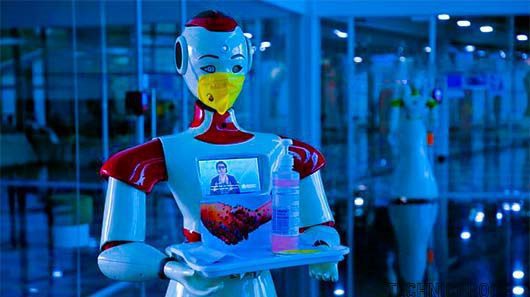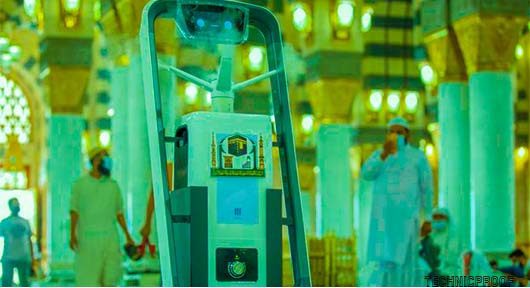Robot or Human Robotic Mobile Machine is equipped with a computer that helps it to perform previously programmed work. With new developments, the robot is entering the world of home, commercial and medical services after entering the world of heavy and precise industries.
Robots or Human Robotic Mobile Machine is equipped with a computer that helps it to perform previously programmed work. With new developments, the robot is entering the world of home, commercial and medical services after entering the world of heavy and precise industries.
Developing a robot made of sugar and gelatin for medical purposes
Re searchers have long tried to develop robots that can swim in the human body to treat diseased tissue. However, these robots were degraded in the water. Today re searchers have come up with a more water proof robot. What are the characteristics of this new discovery?
A team of researchers at Unas Kepler University in Austria developed a robot made of bio degradable materials in the natural environment. According to the study by the scientific journal Science Robotics, re searchers made the robot through stereo typing techniques and using inks made of natural materials.
For years, scientists have been trying to develop soft robots similar to marine organisms, with the aim of using them to swim within the human body to deliver doses of the drug or treat diseased tissue, but the problem they often encountered is that these robots were degraded in the water as well as difficult to shape and short-lived.
Robots made of inks
As part of the new experiment, researchers in Austria used inks made of sugar and gelatin to make robots with a jelly-like texture, adding citric acid to these inks to enhance their formability and make them more water resistant.
During the robot industry, re searchers heated the ink material to facilitate its flow from the printer’s holographic nozzle while making printing in cold weather conditions so that the robot components hardened once the printing was complete.
The researchers initiated the experiment reported by the “Tech Explore” website specializing in robot engine technology, and then created photo transponder sensors to guide the robot during motion. After this phase was completed, the study team successfully manufactured and installed the rest of the robot’s components.
The study team confirmed that all of these components could be inserted back into the stereoscopic printer and dissolved in order to reuse these inks again.
Development of “female” robot in hotels
A study showed that humans feel more comfortable talking with a female robot about males in relation to hospitality and hotel services. What’s the rationale for that? Does this reflect the “prevailing pattern” of type for this segment of posts.

Technology specialist Tek Explore moved the website on Supine Seo, a hotel and hospitality re searcher at Carson Business School in Everett, saying that “humans tend to feel more comfortable receiving service from women because this is the pattern of type for this segment of jobs.”
It added, “This pattern also applies to interactions with robots and is further manifested when robots take on human form.”
Do you have coffee from Robot’s hands?
As part of the experiment, participants in the study were surveyed after dealing with a “man” robot named “Alex” and a female robot named “Sarah”, which had human traits. Participants were more relieved when dealing with the female robot, and this feeling grew in the participants in the experiment when the two robots were given more human features.
Seo emphasized that robotics developers must take the results of this experiment into account when they consider expanding the use of robots in hospitality and hotel”.
Sterilization and epidemic control robots in Saudi Arabia
The Agency for Services, Field Affairs and Environmental Protection, headed by Al-Haramain Affairs in Saudi Arabia, has employed 11 sterilization and epidemic control robots within the Grand Mosque to become the world’s most sterile Makaki mosque.

The Saudi Press Agency (SPA) reported today (Sunday, July 3, 2022), Saudi Arabia employed 11 robots to sanitize the Grand Mosque by covering all its sides, with an automated control system programmed on an advance map, at six levels, improving the safety of the environmental health atmosphere and intelligently analyzing the sterilization requirements, according to use scenarios, the sterilization path, and the duration planned independently for full coverage of environmental space.
The robots were patented SLAM with high performance decomposition module on early warning feature with timely audio broadcast, and possess battery charging feature. One robot operates five to eight hours without human intervention, has a capacity of 23.8 litres, consuming two litres per hour, to eliminate bacteria in an area of 600 square meters each round and can walk three kilos continuously without human intervention.
The dry fog particles used in the sterilization process are five to 15 micrometers in size, the detection of forward impediments exceeds 10 metres, and the device carries a camera with high-quality mapping radar. According to the IAEA, the smart robot device has obtained universal certificates, including the European CE Quality Certification, and the automated sterilization system comes to protect contractors and worshippers from viruses and eliminate all epidemics.


